12.06.2025. Nueva York
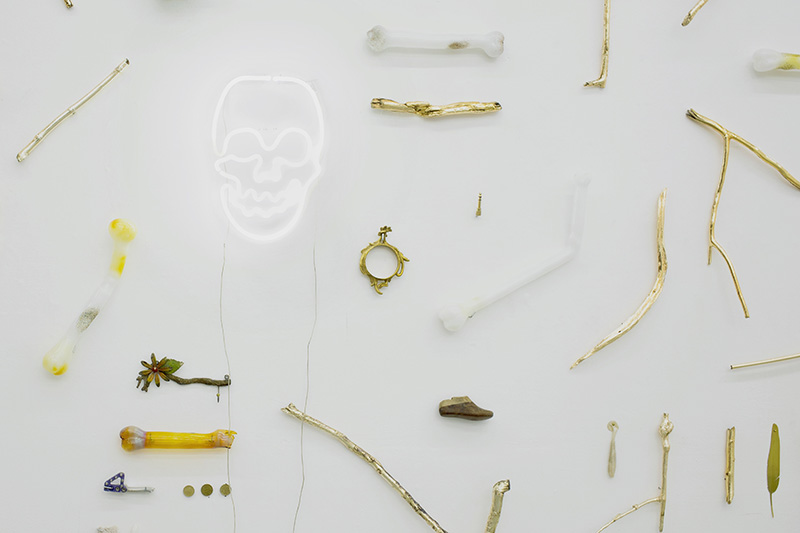
En A Finger Pointing to the Moon, Gabriel Rico convierte la galería Perrotin de Nueva York en un espacio de reflexión sobre lo humano, lo natural y lo simbólico. A través de ensamblajes que combinan cerámica, cera de abeja, ramas, huesos de vidrio y objetos encontrados, el artista mexicano pone en diálogo lo ancestral con lo contemporáneo, lo material con lo espiritual. La muestra —marcada por una profunda sensibilidad hacia la interconexión de especies, formas y saberes— no solo propone una nueva relación entre cuerpo, símbolo y entorno, sino que también nos confronta con nuestra propia vulnerabilidad como especie. En conversación con EXCLAMA, Rico habla sobre espiritualidad, memoria, tecnología y el arte como sistema para reorganizar jerarquías y cuestionar percepciones.
In A Finger Pointing to the Moon, Gabriel Rico transforms Perrotin’s New York gallery into a space for reflection on the human, the natural, and the symbolic. Through assemblages that combine ceramics, beeswax, branches, glass bones, and found objects, the Mexican artist brings ancestral and contemporary, material and spiritual realms into dialogue. The exhibition—marked by a deep sensitivity to the interconnection of species, forms, and knowledge—proposes not only a new relationship between body, symbol, and environment, but also confronts us with our own vulnerability as a species. In conversation with EXCLAMA, Rico speaks about spirituality, memory, technology, and art as a system for reorganizing hierarchies and shaking up perception.
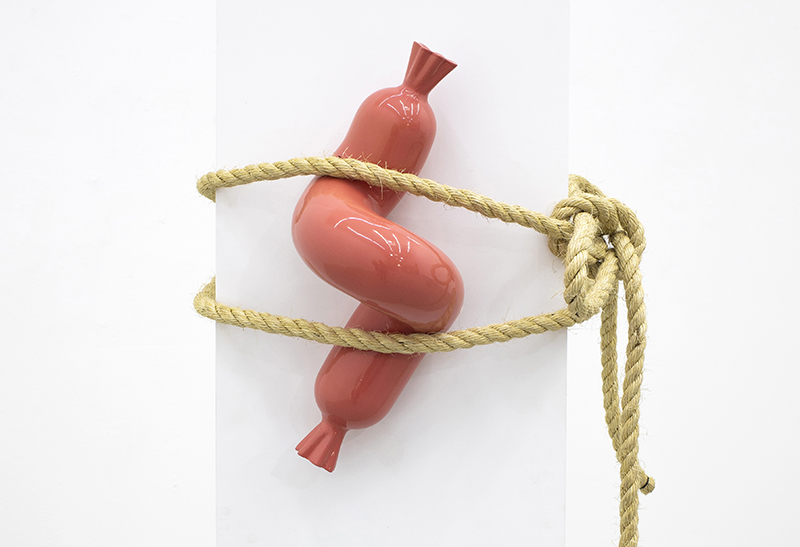
EXCLAMA: Preguntas a Gabriel Rico
EXCLAMA: Questions to Gabriel Rico
Tus obras parecen reconfigurar las jerarquías entre lo humano y lo natural. ¿Crees que el arte puede ayudarnos a imaginar nuevas formas de relacionarnos con estos mundos? ¿Dónde sientes que esta reorganización es más urgente?
GABRIEL RICO: Considero que el arte es un mecanismo a través del cual el hombre puede el humano más bien puede, puede redefinir una posición previamente definida por sistemas jerárquicos, como pueden ser filosóficos, políticos, y económicos. Y el arte tiene la función de sacudir la percepción que tenemos de la realidad para postular una nueva manera, un nuevo sistema. La tecnología que existe en este momento nos da la capacidad de implementar procesos mucho más eficientes hablando de procesos médicos en donde ya no es necesario sacrificar animales para entender su fisonomía…entonces la comunión que hay entre la naturaleza y la tecnología se da a partir del humano.
Hablar de una posible desconexión con la naturaleza me parece una postura super egoísta y hedonista porque pareciera como si pusiéramos al humano al mismo nivel que la naturaleza como en una relación horizontal y no existe una relación horizontal… Nosotros estamos dentro de un sistema y no estamos fuera con el poder.
Your works seem to reconfigure the hierarchies between the human and the natural. Do you think art can help us imagine new ways of relating to these worlds? Where do you feel this reorganization is most urgently needed?
GABRIEL RICO: I consider art to be a mechanism through which humans can define a position previously informed by hierarchical systems, such as philosophical, political, or economic ones. Art has the function of shaking our perception of reality to postulate a new way, a new system. The technology that exists at this moment gives us the capacity to implement much more efficient processes, for example in medical procedures, where it’s no longer necessary to sacrifice animals to understand their physiology, so the only connection between the two is through humans.
Speaking of a possible disconnection from nature seems to me an egocentric and hedonistic position because it puts humans at the same level as nature, as if in an equal relationship, and there is no equal relationship… We are inside a system, and do not have all the power.
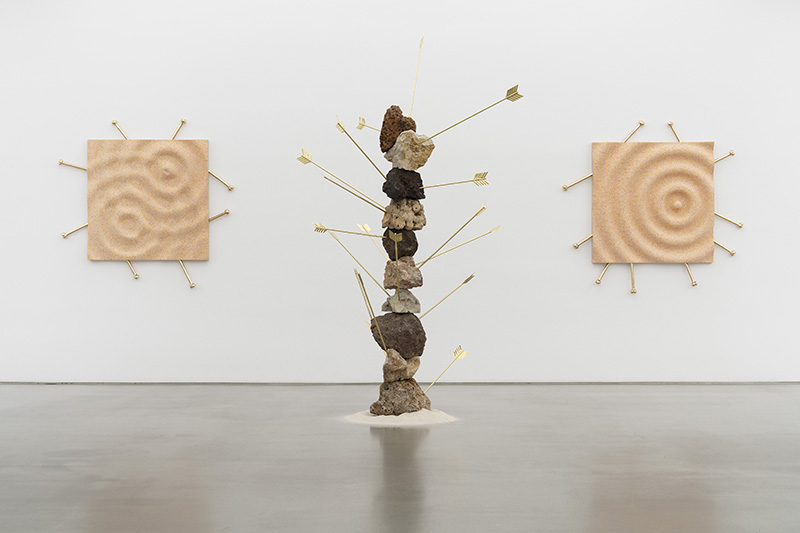
¿Qué ideas o preguntas regresan a ti una y otra vez, incluso cuando no las estás buscando?
GR: Me interesa mucho la parte en la que los procesos mentales tan complejos como la posibilidad de comunicar nuestras ideas encuentran muy factible la posibilidad de utilizar una forma para vaciar completamente todo un concepto y transmitir la información de manera tan efectiva.
What ideas or questions keep returning to you, even when you’re not looking for them?
GR: I’m very interested in how to communicate complex mental processes, and finding a balance where I am able to use physical forms to transmit information and ideas effectively.
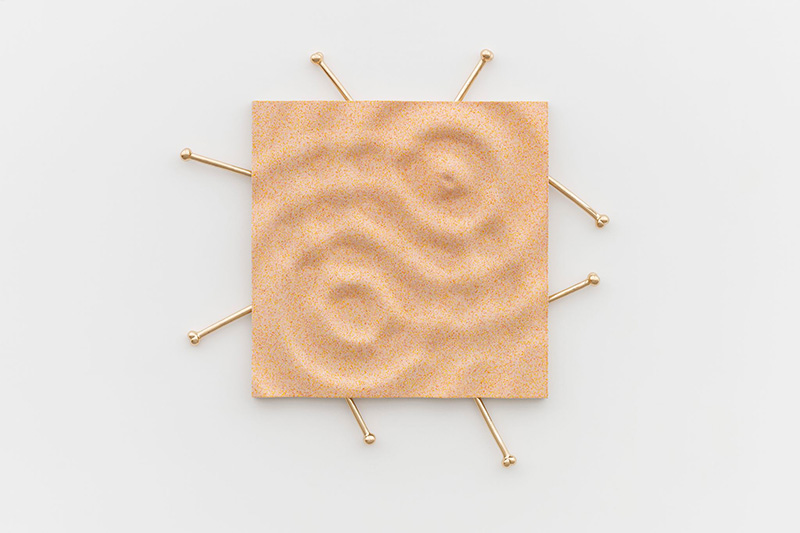
Nierika es muy espiritual. ¿Qué papel juega la espiritualidad en este nuevo cuerpo de trabajo? ¿Qué mensajes guarda tu nierikate?
GR: La palabra nia en la lengua muy RTA significa de frente o frente. Tiene que ver, está relacionada con el concepto de un reflejo o un espejo puede ser una y obviamente el reflejo no solamente es físico, no, el reflejo también es espiritual. Entonces los we, los we rtas le llaman nia esta técnica por cualquier representación artística, porque justamente lo que ellos hacen es proyectar su su persona en en en este. Las piezas que yo hago están hechas con cera de abeja y están pegadas con cera de abejas o hilo de seda, eh? Y está hecha con madera de pino. Esa es una de las formas más tradicionales de hacer estas piezas.
Las piezas nuevas hablan de podrían ser las podría suponer como sistemas, eh, en de ensamblaje en donde nuevos símbolos y símbolos antiguos petroglyphs símbolos provenientes de culturas ancestrales… y nuevos símbolos como el símbolo de para referirnos al átomo a las moléculas, al ADN, el símbolo de la arroba del hashtag, el símbolo de ex exclamación de peligro.
Nierika is highly spiritual. What role does spirituality play in this new body of work? What messages do your nierikate hold?
GR: The word nia in the wuerta language means facing or front. It’s related to the concept of a reflection or mirror, and obviously the reflection is not only physical, the reflection is also spiritual. So the wertas call this technique nia for any artistic representation, because precisely what they do is project their person into this artwork. The pieces I create are made with beeswax, silk thread, and with pine wood. That is one of the most traditional ways of making these pieces.
My new artworks could be considered as assemblages of systems with ancient symbols–petroglyphs, symbols from ancestral cultures– are combined with new symbols–the atom, molecules, DNA, the @ symbol, the hashtag, the exclamation or danger symbol.
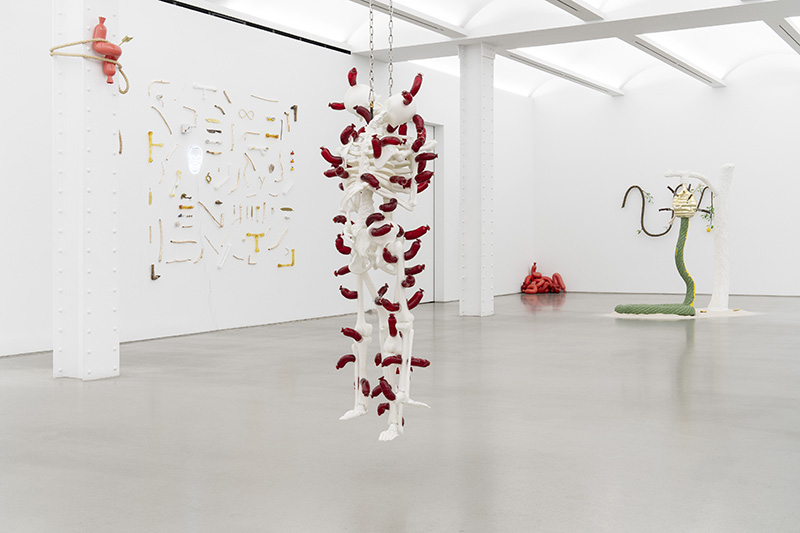
¿Crees que aún percibimos la naturaleza como algo utilitario? ¿Qué papel puede jugar el arte en transformar esa percepción?
GR: Yo me considero una persona, un humano antes de un artista. El arte funciona como un método para encontrar respuestas relacionadas con preguntas que se generan. Pues a nivel eh, existencial, como las preguntas básicas de qué soy, quién soy, a dónde quiero ir, eh? ¿Por qué existo? ¿Por qué tengo esta forma? ¿Por qué la escala de mi cuerpo?
Es como si, cuando eres pequeño, la memoria está construida por ciertos detalles que te remiten a ciertos momentos como la textura del cabello de tu madre, como el olor de tu madre, como el color del jabón. El proceso de concretar o sugerir una forma a una idea viene acompañado de un proceso de vida como físicamente, hacer y ser consciente de lo que estás haciendo como artista, no estoy en mi estudio y de repente llega la idea genial y decir, bueno, pues esto tiene esta forma y se hace de esta forma, sino que todo el tiempo estoy recolectando información, experiencias, objetos.
El objeto que encontré en las calles de Nueva York me lo voy a llevar miles de kilómetros a México a mi estudio y puede estar ahí años hasta que en algún momento el objeto me vuelva a importar.
Do you think we still perceive nature as something utilitarian? What role can art play in shifting that perception?
GR: I consider myself a person, a human, before an artist. Art functions as a method to find answers to questions. Well, at an existential level, the basic questions of what am I, who am I, where do I want to go? Why do I exist? Why do I have this form? Why the scale of my body?
I believe that in the process of growing up as an evolving human, we continually expand our perception of the world. It’s as if, when you’re little, memories are built by certain details that remind you of certain moments, like the texture of your mother’s hair, your mother’s smell, the color of soap. The process of associating a form to an idea is accompanied by a life process of physically doing and being conscious of what you’re doing. As an artist, I’m not in my studio and suddenly a brilliant idea arrives and I say, well, this has this form and is made this way, but rather I’m constantly collecting information, experiences, objects.
Objects I find on the streets of New York, I’ll take thousands of kilometers to Mexico to my studio and they can stay there for years until at some point the objects become important to me again.
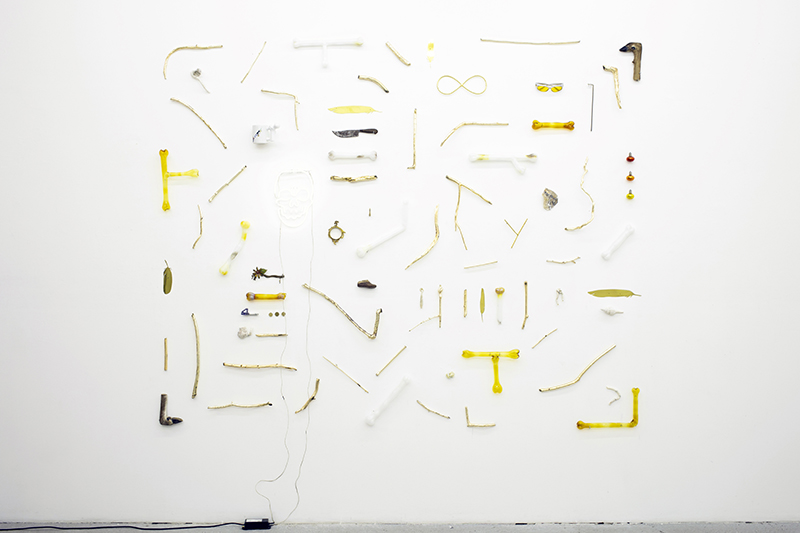
¿Qué ideas estás explorando en esta nueva exposición en Perrotin de Nueva York? ¿Qué significa el título, ‘Un dedo apuntando a la luna’?
GR: El título sugiere un gesto personalmente encuentro muy poético y delicado porque habla de la escala comparativa que hay entre un dedo y un cuerpo celeste como la luna. Más que un concepto es una sugerencia para entender nuestro cuerpo como medio para suponer una posición. En este caso, yo sugiero mi cuerpo como un factor a través del cual puedo experimentar que ser un humano, pero también como factor de medición para expresar la vulnerabilidad, no solo de mi persona, pero de toda mi percepción personal, como humano, somos bastante efímeros. La mayor parte de la obra que presento en la galería habla de la posibilidad de interacción que hay entre las diferentes especies.
Puede ser que un astrofísico o astrónomo esté señalando la luna a un grupo de estudiantes, a un amigo, a un compañero de observación. Puede ser que una abuela le esté señalando la luna llena, eh? O la luna menguante a a a su nieto, explicando un poco la forma o el el color puede ser que un un grupo de amigos, eh, después de haber esté salido en la noche, se dan cuenta de la belleza de la luna llena
La exposición presenta una obra única hecha con nierika. Son de color rosado que, vistos de lejos, parecen de un color sólido, pero al acercarse se revela que están compuestos por 10 u 11 colores diferentes. Esta obra hace referencia a la piel de un cerdo y al momento en que es tocado por un objeto externo (un dedo humano, una rama, una varilla, un castigador eléctrico, o una lanza). La pieza busca capturar la onda expansiva microscópica que se produce en ese momento de contacto, explorando la interacción entre el micromundo y el macromundo, que es uno de los temas centrales de interés en esta exposición.
What ideas are you exploring in this new exhibition at Perrotin New York? What does the title, ‘A Finger Pointing to the Moon,’ mean?
GR: The title suggests a gesture I personally find very poetic and delicate because it speaks of the comparative scale between a finger and a celestial body like the moon. More than a concept, it’s a suggestion to understand our body as a means to establish a position. In this case, my body can be a tool through which I can experience being an individual human, but also as a tool to express vulnerability, not only of my person, but of my entire human race. As humans, we are quite ephemeral. Most of the work I present in the gallery explores the possibility of interaction between different species.
From there, the “finger” in the title that is pointing at celestial bodies is unknown. It could be that an astrophysicist or astronomer is pointing at the moon to a group of students, to a friend, to an observation companion. It could be that a grandmother is pointing out the full moon or the waning moon to her grandchild, explaining a bit about the shape or the color. It could be that a group of friends, after having gone out at night, notice the beauty of the full moon and point at it.
The exhibition features a unique series made with nierika, titled The propagation of Us. These are pink-colored works that, when viewed from a distance, appear to be a solid color, but upon closer inspection reveal a composition of 10 or 11 different colors. This work references a pig’s skin and the moment it is touched by an external object (a human finger, a branch, a rod, an electric prod, or a spear). The piece aims to capture the microscopic expansive wave produced at that moment of contact, exploring the interaction between the microworld and the macroworld, which is one of the central themes of interest in this exhibition.
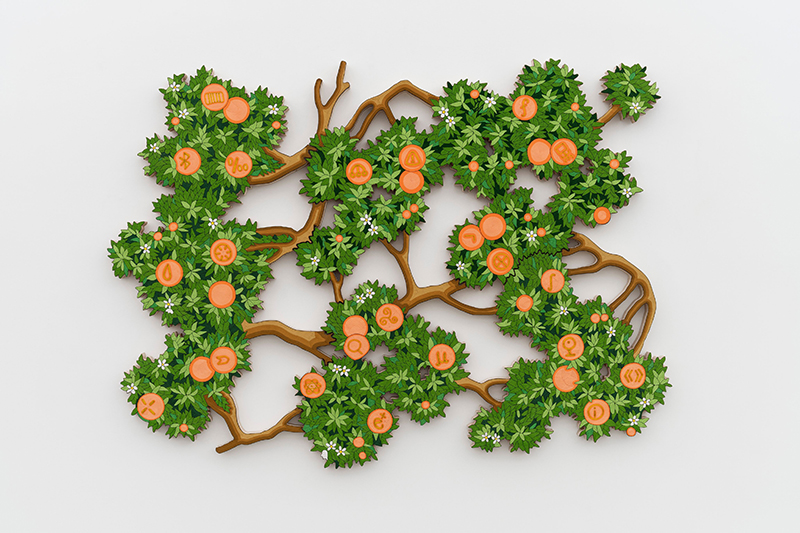
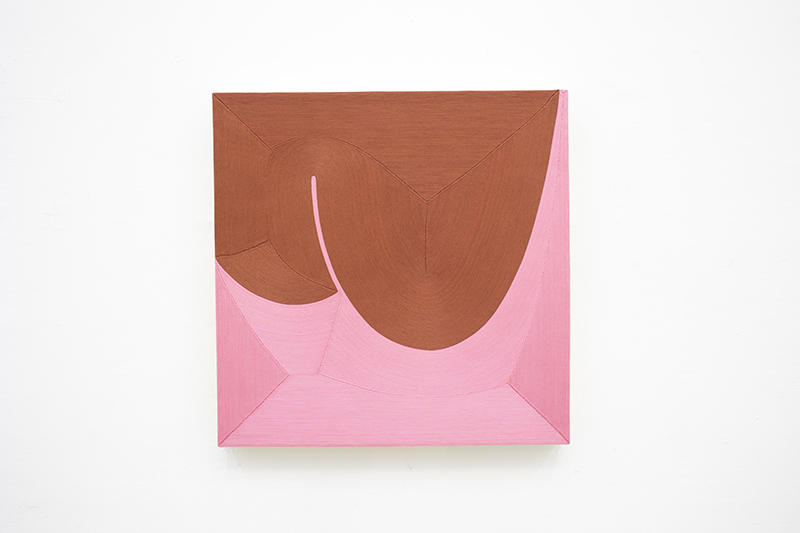
Con A Finger Pointing to the Moon, Gabriel Rico nos recuerda que el arte no es solo representación, sino una herramienta para reconfigurar el mundo que habitamos. Sus obras invitan a observar con más cuidado, a cuestionar y reconocer los vínculos invisibles que nos conectan con todo lo que nos rodea.
With A Finger Pointing to the Moon, Gabriel Rico reminds us that art is not merely representation, but a tool for reconfiguring the world we inhabit. His works invite us to look more closely, to question, and to recognize the invisible connections that bind us to everything around us.
PERROTIN. NEW YORK
Abierta al público hasta agosto 1, 2025
130 Orchard Street
Nueva York, NY 10002
Martes a sábados de 10 am a 6 pm

